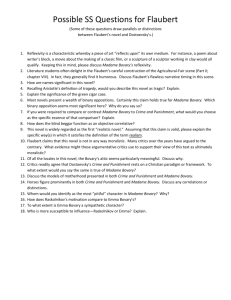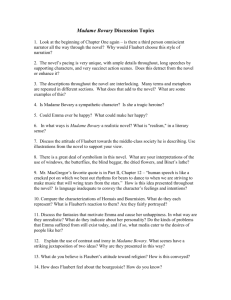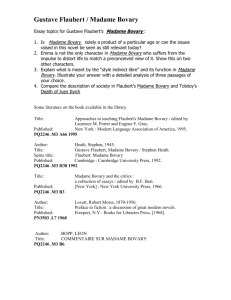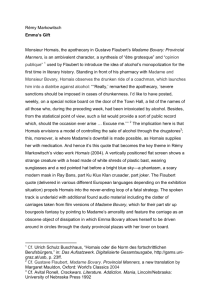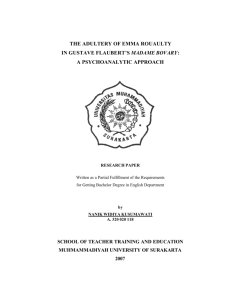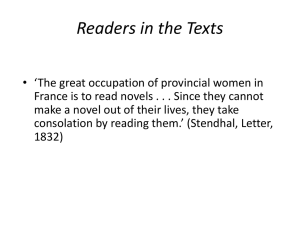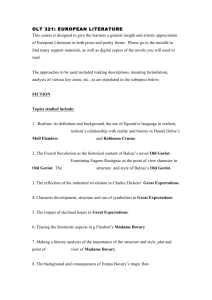‘MADAME BOVARY, C’EST MOI’ —signed, Vincente Minnelli
advertisement
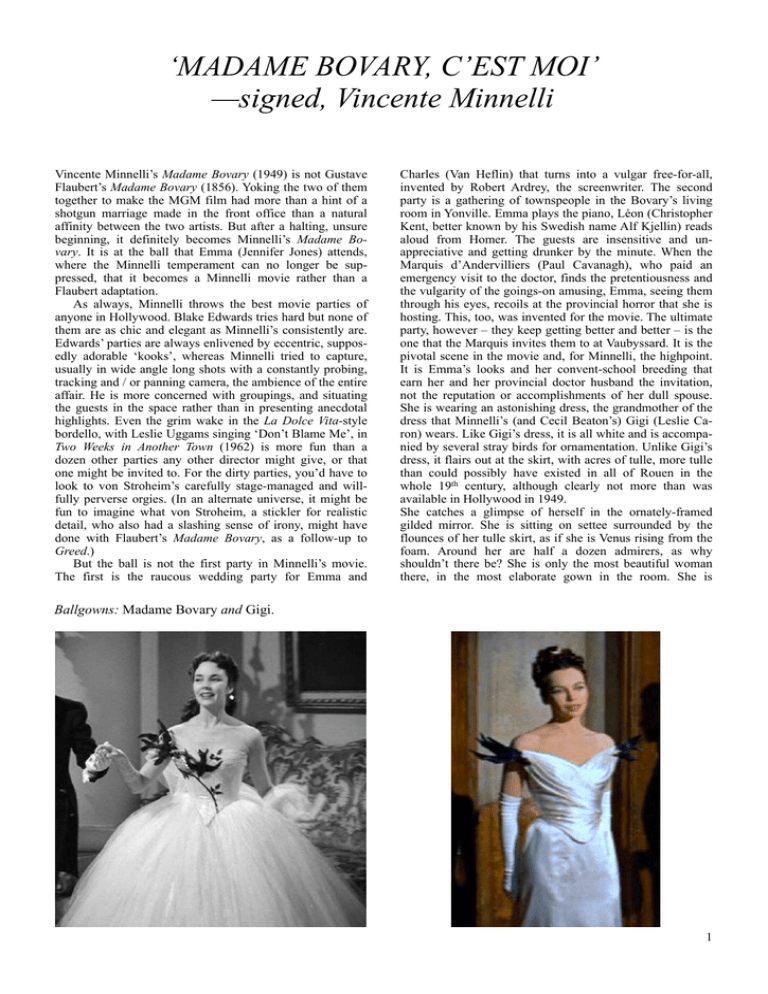
‘MADAME BOVARY, C’EST MOI’ —signed, Vincente Minnelli Vincente Minnelli’s Madame Bovary (1949) is not Gustave Flaubert’s Madame Bovary (1856). Yoking the two of them together to make the MGM film had more than a hint of a shotgun marriage made in the front office than a natural affinity between the two artists. But after a halting, unsure beginning, it definitely becomes Minnelli’s Madame Bovary. It is at the ball that Emma (Jennifer Jones) attends, where the Minnelli temperament can no longer be suppressed, that it becomes a Minnelli movie rather than a Flaubert adaptation. As always, Minnelli throws the best movie parties of anyone in Hollywood. Blake Edwards tries hard but none of them are as chic and elegant as Minnelli’s consistently are. Edwards’ parties are always enlivened by eccentric, supposedly adorable ‘kooks’, whereas Minnelli tried to capture, usually in wide angle long shots with a constantly probing, tracking and / or panning camera, the ambience of the entire affair. He is more concerned with groupings, and situating the guests in the space rather than in presenting anecdotal highlights. Even the grim wake in the La Dolce Vita-style bordello, with Leslie Uggams singing ‘Don’t Blame Me’, in Two Weeks in Another Town (1962) is more fun than a dozen other parties any other director might give, or that one might be invited to. For the dirty parties, you’d have to look to von Stroheim’s carefully stage-managed and willfully perverse orgies. (In an alternate universe, it might be fun to imagine what von Stroheim, a stickler for realistic detail, who also had a slashing sense of irony, might have done with Flaubert’s Madame Bovary, as a follow-up to Greed.) But the ball is not the first party in Minnelli’s movie. The first is the raucous wedding party for Emma and Charles (Van Heflin) that turns into a vulgar free-for-all, invented by Robert Ardrey, the screenwriter. The second party is a gathering of townspeople in the Bovary’s living room in Yonville. Emma plays the piano, Léon (Christopher Kent, better known by his Swedish name Alf Kjellin) reads aloud from Homer. The guests are insensitive and unappreciative and getting drunker by the minute. When the Marquis d’Andervilliers (Paul Cavanagh), who paid an emergency visit to the doctor, finds the pretentiousness and the vulgarity of the goings-on amusing, Emma, seeing them through his eyes, recoils at the provincial horror that she is hosting. This, too, was invented for the movie. The ultimate party, however – they keep getting better and better – is the one that the Marquis invites them to at Vaubyssard. It is the pivotal scene in the movie and, for Minnelli, the highpoint. It is Emma’s looks and her convent-school breeding that earn her and her provincial doctor husband the invitation, not the reputation or accomplishments of her dull spouse. She is wearing an astonishing dress, the grandmother of the dress that Minnelli’s (and Cecil Beaton’s) Gigi (Leslie Caron) wears. Like Gigi’s dress, it is all white and is accompanied by several stray birds for ornamentation. Unlike Gigi’s dress, it flairs out at the skirt, with acres of tulle, more tulle than could possibly have existed in all of Rouen in the whole 19th century, although clearly not more than was available in Hollywood in 1949. She catches a glimpse of herself in the ornately-framed gilded mirror. She is sitting on settee surrounded by the flounces of her tulle skirt, as if she is Venus rising from the foam. Around her are half a dozen admirers, as why shouldn’t there be? She is only the most beautiful woman there, in the most elaborate gown in the room. She is Ballgowns: Madame Bovary and Gigi. 1 looking into the mirror, we are looking into the mirror seeing her looking into the mirror. Our eyes meet. She is no longer Emma Bovary, dreary wife of an even drearier, unambitious country doctor. Perhaps she is experiencing is what academics might call a Lacanian ‘mirror phase’ moment. She sees herself, at last, as the person she always wished herself to be and can’t reconcile that image to the person she once was. What she sees is what we have already known and what she has intuited – that she is Jennifer Jones, Hollywood star, star of a movie made by MGM, the quality studio, famous for its quality literary adaptations, and directed by its most visually adventurous director, perhaps the greatest visual stylist in all of Hollywood, Vincente Minnelli. Everything she has ever dreamed and fantasised and hoped for is in that mirror. Mirrors in Minnelli’s movies are very different from mirrors in, for example, Douglas Sirk’s movies. In Sirk’s films, mirrors are confining walls that reflect back the shallowness of the characters’ lives. While they suggest open spaces, the mirrors themselves impose rigid physical boundaries on the characters, seemingly giving them the sense of freedom and multiplicity, but actually trapping them in highly-structured webs of mirror-lined tombs. The mirrors create a deep space but are a reflection of the characters’ shallow understanding of themselves and the world they live in – a world of vulgar but expensive things and gaudy objects. And even though they don’t know it, the characters themselves are merely pieces of furniture in the décor that defines them. In Minnelli, mirrors are used to give the characters a glimpse into themselves. It’s a rare moment of communion: they look, however briefly, into their own eyes and acknowledge a strength of character or a moment of truth that they were unable to recognise earlier. They lock eyes with the mirror for a split second and they are able to confront themselves and the world they inhabit. Minnelli’s Mirrors. In this column: Gigi. On the right, from top to bottom: The Pirate, Two Weeks in Another Town and The Bad and The Beautiful. 2 Madame Bovary has made a choice. She is no longer Flaubert’s Emma Bovary, or even Phyllis Isley, Jennifer Jones’ real name. She is Minnelli’s Emma Bovary. She is Jennifer Jones / Mrs. David O. Selznick. Jean-Pierre Melville, whose name is not often linked with Minnelli's, also has his heroes / anti-heroes exchange glances with their mirror image. ‘A man before a mirror means a stock-taking’, he said (Noguiera 1971: 54-5). But it's usually an actor, as he adjusts the brim of his perfect Fedora, inexpressively looking into the void, preparing for his existentialist date with Destiny. Back to Emma. She adores the spectacle of herself as others see her and as she has always wished herself to be. That one look validates her most impossible dreams. She has dreamed herself into the mirror and can now enter it fully, with vertiginous abandon. In the book, she is one of several dozen guests, an extra at the party. In the movie, she is one of perhaps a couple of hundred, no longer an extra but the star performer. In that one shot, she sees herself, as we all do to some extent or other, as the star in her own movie, the men surrounding her are bit players, supernumeraries in her drama. That single glance permits the fantasy to continue forward. She is no longer the drab Madame Bovary Flaubert described; she is the star in a Vincente Minnelli movie and the world must take notice. In the very next shot, Prince Charming, summoned by what she has seen in the mirror, comes over and asks her to dance with him. He comes into the frame. As Rodolphe, the impossibly handsome Louis Jourdan, who could only exist in the movies and never in the real world, sees her as she sees herself, the most attractive and desirable woman at the ball. He must have her. Of course, he is the most attractive man there, and that is as it should be – because they are both part of the Hollywood star machine. She thinks her life is now beginning but it is really the beginning of the end, her headlong miserable flight from reality that will culminate in her suicide. The fantasy ball that she attends is a pure Minnelli creation and captures his imagination as most of the rest of the movie does not. The camera swirls, the dancers drunk with waltzing are turning into a blur of elaborate ball gowns and tailcoats. The crystal chandeliers glitter and shine as they never have before. The camera makes a 360-degree sweep around the elaborate set with Emma and Rodolphe, at the center of the frame, as they waltz. It is no longer a dinky provincial ball thrown by a minor member of the nobility. It is a ball worthy of a king. And the star of it is Minnelli’s Cinderella, dancing herself to exhaustion to Miklos Rosza’s ‘neurotic waltz’, with its Ravel-like tune. Perhaps she has escaped from a Minnelli musical, a cutting-room reject from his Ziegfeld Follies (1946). The waltzing seems to go on forever. Let it. Let it continue to the end of the film and beyond. She is ready to faint from the endless spinning, from the surfeit of luxe, from the first heady taste of a life as she knew she was always meant to live it. As she begins to swoon, Rodolphe calls for fresh air. The Marquis cavalierly orders his windows to be smashed. Only at MGM. Or in film by von Stroheim. Real nobility, hedonistically extravagant and penny-pinching at the same time, has too an acute awareness of how much replacing a smashed window costs to allow themselves such fanciful whims. We are no longer in Flaubert’s Madame Bovary and have successfully passed through the looking-glass into Vincente Minnelli’s Madame Bovary. The man who wanted to write a book that would have all the glamour of the colour of wood lice would hardly recognise the romantic, impressionistic carnival his down-at-heel country ball has become. Minnelli himself has indeed become Madame Bovary, his Madame Bovary, not Flaubert’s. Actually, Flaubert's rarely read novel, Salammbô (1862), which he said was meant to evoke the colour yellow, is something that would have been more conducive to Minnelli’s visual imagination than Madame Bovary. The suffocating, overwrought, visually heightened style of this virtuosic exercise in perfumed Orientalism, as well as flirtation with sado-masochism, would definitely have been more to Minnelli’s taste. But Salammbô, the book, is not nearly as famous a ‘property’ in the finest Hollywood sense, as the famous and notorious Madame Bovary is. Perhaps someday, but not today, and not in 1949, either. The closest anyone in Hollywood came to filming Salammbô was Orson Welles, when he has Susan Alexander Kane in Citizen Kane (1941) perform an aria from the opera, Salaambo, with a different spelling, as written by Bernard Herrmann. Leave Flaubert’s desiccated, detailed and detached Madame Bovary, the colour of woodlice, for William Wyler, who specialised in uninspired, precision, by-the-numbers adaptations likeThe Heiress (1949) (based on Henry James’ novella, Washington Square, 1881) and Carrie (1952) (based on Theodore Dreiser’s Sister Carrie, 1900) and didn’t even know he was doing this – clearly the wrong man for Emily Brontë’s over heatedly romantic, emotionally fraught Wuthering Heights (1847). Almost as if by accident, the moment in which Emma finds herself in the center of the mirror corresponds brilliantly to a section much later in the book in which Bovary takes her to the opera in Rouen to see Donizetti’s Lucia di Lammermoor (1835). As soon as she enters the opera house, she feels that her life is transformed. She is overwhelmed by the spectacle of the palace itself and then the spectacle that is presented there. She has no interest in the opera, she has no interest in music. She is, however, interested in the romance of far-away exotic places – another place, another century, in which Sir Walter Scott’s story takes place, a story she fell in love with when she was a girl at the convent. She is interested in the theatricality and make-believe 3 of the theatre – the painted flats, the costumed and elaborately made-up singers, the theatricality of the gestures. She is interested in the misunderstood and falsely maligned heroine, a woman who lives for love, goes mad for love, kills for love, and dies for love. This she can identify with. From her box at the opera, she sees herself as the conquest of Lagardy, the famous (fictional) tenor in the role of Edgardo, with all the glory that, she thinks, goes with the territory. It is as if she is looking at the opera through the wrong end of the opera glasses. She imagines that Lagardy has made eye contact with her, as every good actor seems to attempt to do with each member of his captive audience, just as she has made eye contact with us when she looks into the mirror. terminate in sensory experience, are given, the emotion is immediately evoked. (Eliot 1919: 92) If Minnelli’s (and Jones’) mirror in the ballroom scene is a betrayal of the ball in Flaubert, it is certainly an accurate translation of Emma at the opera. She will momentarily fall in love with the hero of the opera, and the singer singing the role, imagining herself as, if not the heroine in the opera, the mistress of the tenor singing the role. In effect, she can see nothing more when she looks out at the world, than her own reflection in the mirror. The curtain falls. His love, she thought, must be inexhaustible, since he could pour it out in such quantities. Her resolution not to be taken in by the display of false sentiment was swept away by the impact of the singer’s eloquence; the fiction that he was embodying drew her to his real life, and she tried to imagine what it was like – that glamorous, fabulous, marvelous life that she, too, might have lived had chance so willed it. They might have met! They might have loved! With him she might have traveled over all the kingdoms of Europe, from capital to capital, sharing his hardships and his triumphs, gathering up the flowers his admirers threw, embroidering his costumes with her own hands; and every night behind the gilded lattice of her box she might have sat open-mouthed, breathing in the outpourings of that divine creature who would be singing for her alone: he would have gazed at her from the stage as he played his role. A mad idea seized her: he was gazing at her now! She was sure of it! She longed to rush into his arms and seek refuge in his strength as in the very incarnation of love; she longed to cry ‘Ravish me! Carry me off! Away from here! All my passion and dreams are yours—yours alone!’ The curtain fell. Flaubert: ([1856] 1991: 254-55). She has completely re-written the opera, with a starring role for herself. In fact, she is no longer paying attention to the opera, caught up as she is in a dream scenario of her own. She has willed herself into a fantasy in which her real presence – she is nothing more than a paying customer, an anonymous spectator in the dark, one of the many faceless bodies that comprise an audience – counts for very little. The mirror shot in the film is the obverse of her Lagardy reverie at the opera. In a sense, her putting herself onto the opera stage with Lagardy is very much like her seeing herself in the mirror in the Minnelli film. She fits herself into a frame and a world that is completely unaware of her. In the mirror moment, Minnelli very accurately captures the dull, hyperventilating aspirations of a Madame Bovary who, entranced by her own drama, is more to be pitied than scorned, more to be chided than punished. Minnelli has found, as literature students in the 1960s used to say, ‘the objective correlative’, the visual equivalent for Emma Bovary’s emotional situation. The ‘objective correlative’, as stated by T. S. Eliot, is this: The only way of expressing emotion in the form of art is by finding an ‘objective correlative’; in other words, a set of objects, a situation, a chain of events which shall be the formula of that particular emotion; such that when the external facts, which must 4 The ornate mirror used in the ball scene was obviously part of MGM’s vast storehouse of props. These last two images are from Ziegfield Follies (1946) and To Please a Lady (Clarence Brown, 1950). Mark Rappaport Mark Rappaport made 9 feature films including, The Scenic Route (1978), Imposters (1979), Rock Hudson’s Home Movies (1992), and From the Journals of Jean Seberg (1995). He currently lives in Paris. A collection of his writings, edited by Raymond Bellour, was published in 2008 in French ‘Le Spectateur qui en savait trop’ (‘The Moviegoer Who Knew Too Much’). He also makes film-related photomontages and has had exhibitions at the New York Film Festival and other film festivals. Works Cited Eliot, T.S. (1919): ‘Hamlet and His Problems,’ in The Sacred Wood: Essays on Poetry and Criticism (1920). London: Methuen & Co. Flaubert, Gustav ([1856] 1991): Madame Bovary. Translated by Francis Steegmuller (1957). New York: Random House. Noguiera, Ruy (1971) Melville on Melville. London: Secker and Warburg. © Mark Rappaport, 2011 Movie: A Journal of Film Criticism, 2. 5

